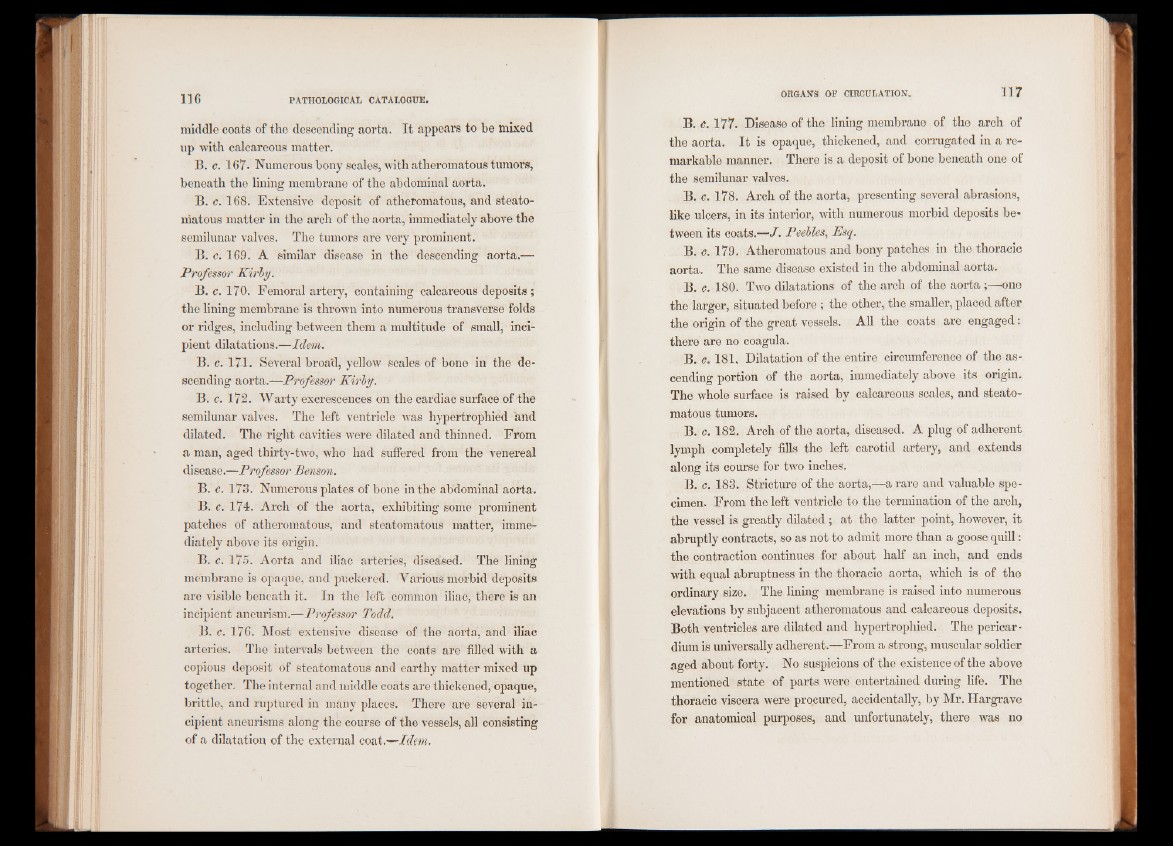
middle coats of the descending aorta. It appears to be mixed
up with calcareous matter.
B. c. 167. Numerous bony scales, with atheromatous tumors,
beneath the lining membrane of the abdominal aorta.
B. c. 168. Extensive deposit of atheromatous, and steatomatous
matter in the arch of the aorta, immediately above the
semilunar valves. The tumors are very prominent.
B. c. 169. A similar disease in the descending aorta.—
Professor Kirby.
B. c. 170. Femoral artery, containing calcareous deposits;
the lining membrane is thrown into numerous transverse folds
or ridges, including between them a multitude of small, incipient
dilatations.—Idem.
B. c. 171. Several broa’d, yellow scales of bone in the descending
aorta.—Professor Kirby.
B. c. 172. Warty excrescences on the cardiac surface of the
semilunar valves. The left ventricle was hypertrophied and
dilated. The right cavities were dilated and thinned. From
a man, aged thirty-two, who had suffered from the venereal
disease.—Professor Benson.
B. c. 173. Numerous plates of bone in the abdominal aorta.
B. c. 174. Arch of the aorta, exhibiting some prominent
patches of atheromatous, and steatomatous matter, immediately
above its origin.
B. c. 175. Aorta and iliac arteries, diseased. The lining
membrane is opaque, and puckered. Various morbid deposits
are visible beneath it. In the left common iliac, there is an
incipient aneurism.—Professor Todd.
B. c. 176. Most extensive disease of the aorta, and iliac
arteries. The intervals between the coats are filled with a
copious deposit of steatomatous and earthy matter mixed up
together. The internal and middle coats are thickened, opaque,
brittle, and ruptured in many places. There are several incipient
aneurisms along the course of the vessels, all consisting
of a dilatation of the external coat.—Idem.
B. c. 177. Disease of the lining membrane of the arch of
the aorta. It is opaque, thickened, and corrugated in a remarkable
manner. There is a deposit of bone beneath one of
the semilunar valves.
B. c. 178. Arch of the aorta, presenting several abrasions,
like ulcers, in its interior, with numerous morbid deposits between
its coats.—J. Peebles, Esq.
B. c. 179. Atheromatous and bony patches in the thoracic
aorta. The same disease existed in the abdominal aorta.
B. c. 180. Two dilatations of the arch of the aorta;—one
the larger, situated before ; the other, the smaller, placed after
the origin of the great vessels. All the coats are engaged:
there are no coagula.
B. c. 181. Dilatation of the entire circumference of the ascending
portion of the aorta, immediately above its origin.
The whole surface is raised by calcareous scales, and steatomatous
tumors.
B. c. 182. Arch of the aorta, diseased. A plug of adherent
lymph completely fills the left carotid artery, and extends
along its course for two inches.
B. c. 183. Stricture of the aorta,—a rare and valuable specimen.
From the left ventricle to the termination of the arch,
the vessel is greatly dilated; at the latter point, however, it
abruptly contracts, so as not to admit more than a goose quill:
the contraction continues for about half an inch, and ends
with equal abruptness in the thoracic aorta, which is of the
ordinary size. The lining membrane is raised into numerous
elevations by subjacent atheromatous and calcareous deposits.
Both ventricles are dilated and hypertrophied. The pericardium
is universally adherent.—From a strong, muscular soldier
aged about forty. No suspicions of the existence of the above
mentioned state of parts were entertained during life. The
thoracic viscera were procured, accidentally, by Mr. Hargrave
for anatomical purposes, and unfortunately, there was no